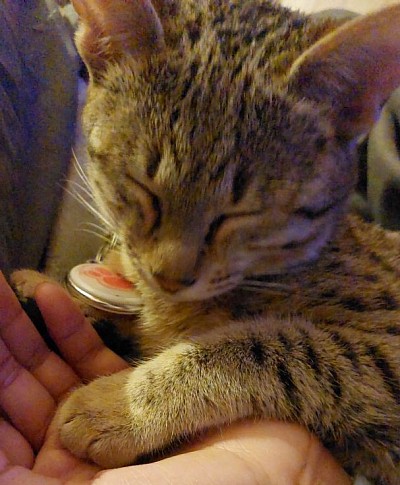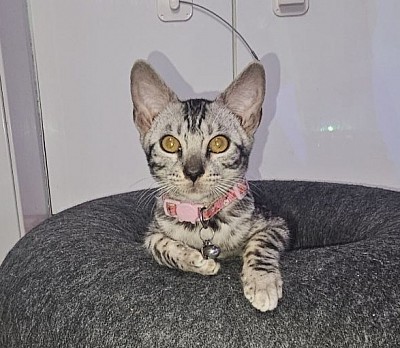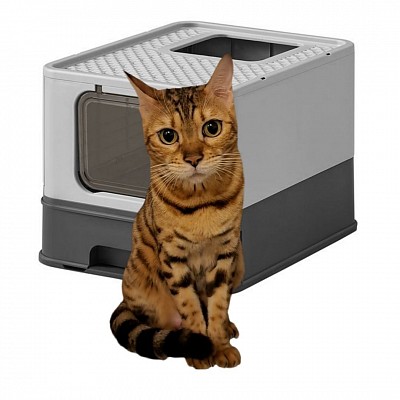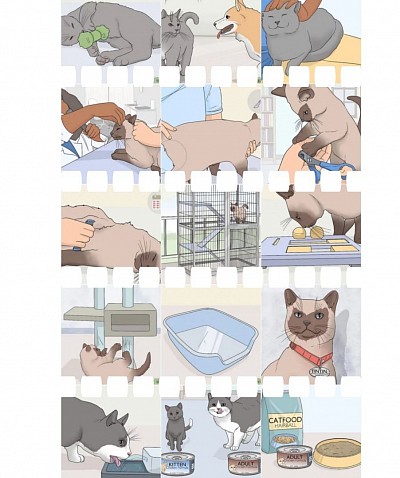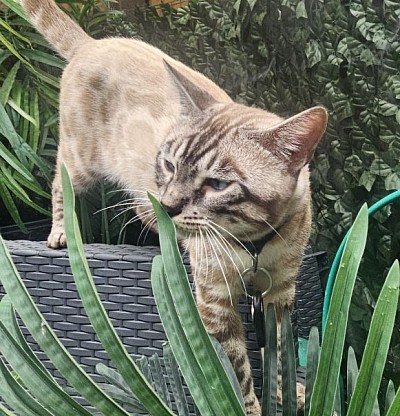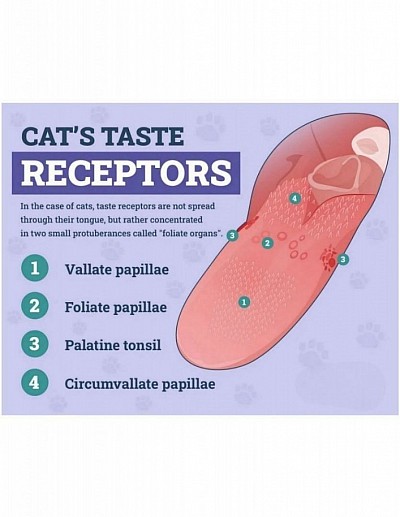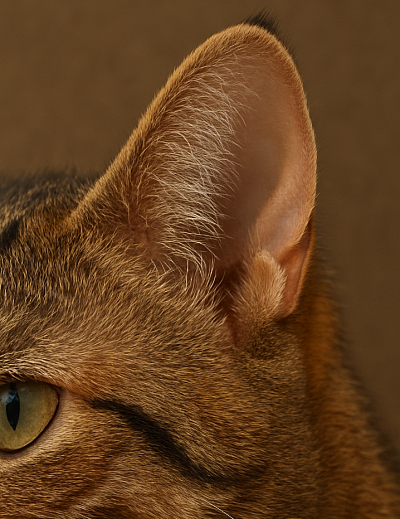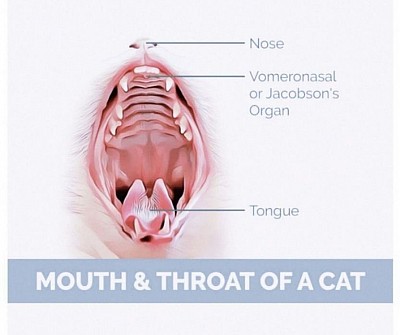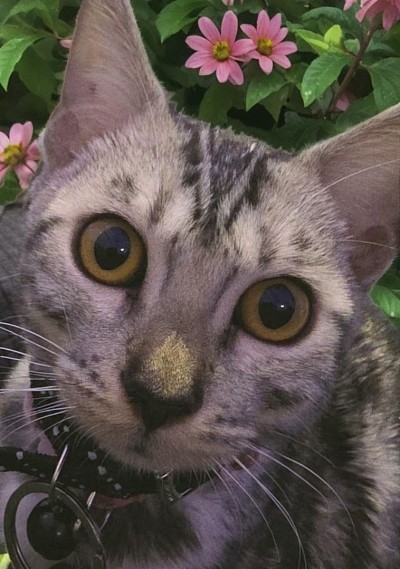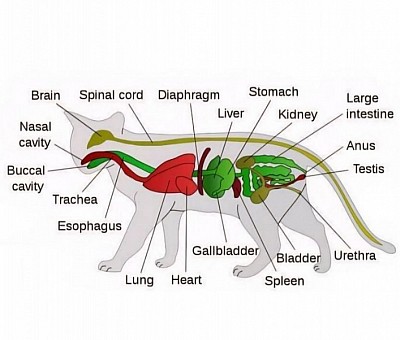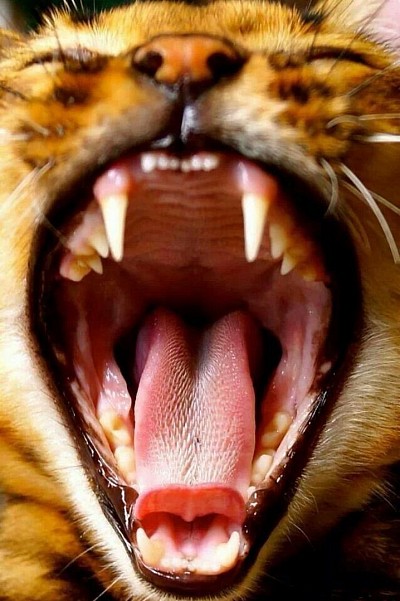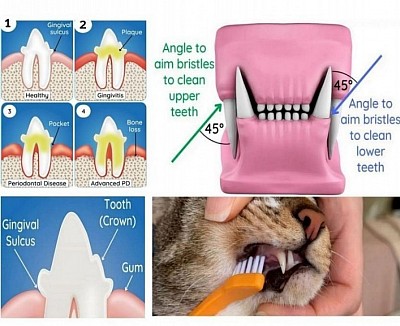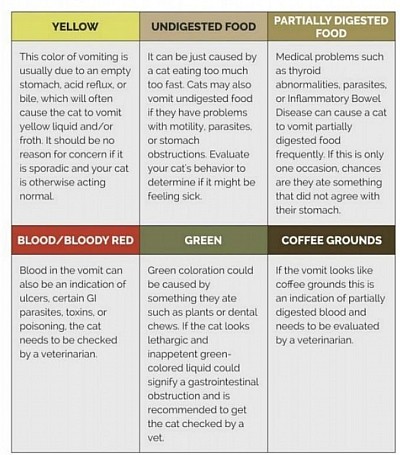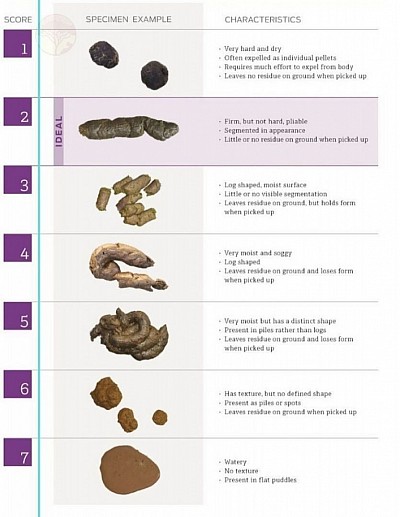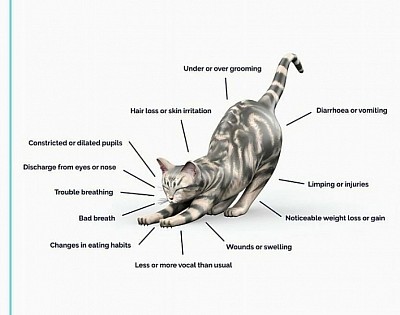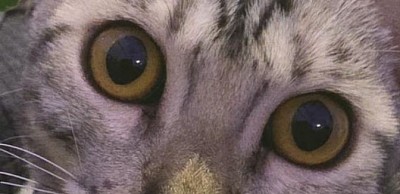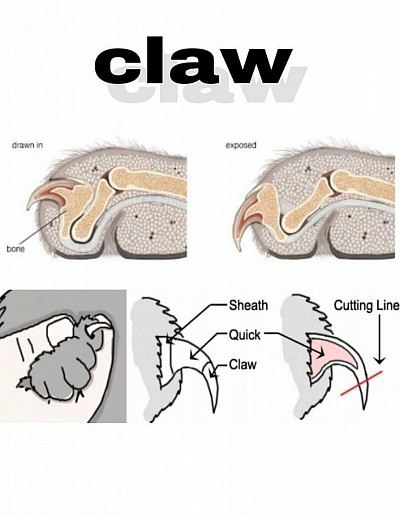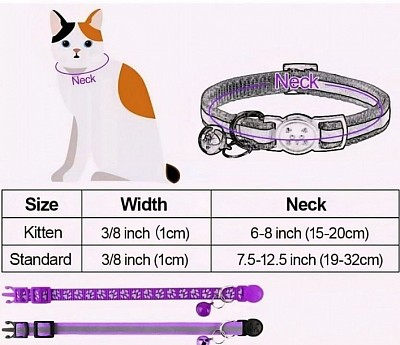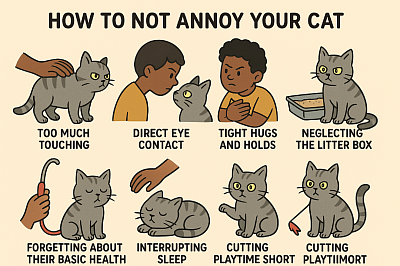Care and Maintenance of Your Cat's Well-Being
Cat Care and Well-Being Management
Taking care of a cat includes meeting its basic needs such as food, water, and shelter. It is also important to ensure the cat’s physical and mental well-being through regular play, grooming, and veterinary care. Creating a safe and engaging environment, along with providing consistent attention and affection, is essential for keeping your feline companion happy and healthy.
Comprehensive Care Guidelines for Bengal and Savannah Cats
Caring for a Bengal or Savannah cat takes some dedication and experience. These lively breeds need plenty of stimulation, lots of vertical space to climb, and both physical and mental exercise to keep boredom—and the naughty behaviours that come with it—at bay. To keep them happy, make sure they have big, interactive cat trees, scratching posts, and a variety of toys. Don’t forget to offer top-notch food and regular grooming. Keep their litter box clean and roomy, and think about building a safe outdoor space like a catio. Bengals and Savannahs love spending time with people and shouldn’t be left alone for too long.
Environment and Enrichment
- Vertical Space: These cats love climbing and perching, so provide large, multi-level cat trees, shelves, and scratching posts.
- Mental Stimulation: Keep their sharp minds busy with interactive toys, puzzle feeders, and training sessions using positive reinforcement and treats.
- Safe Outdoor Access: A secure outdoor enclosure or “catio” is a great way to let them explore safely. Never let them roam outside unsupervised.
Exercise and Play
- High Activity Needs: These energetic cats need daily playtime to burn off their extra energy.
- Interactive Play: Use chaser toys or a laser pointer for fun, interactive games. Always finish the play session with a treat or a real toy to keep frustration away.
Grooming
- Regular Brushing: Brush their coat weekly to get rid of loose hair, prevent hairballs, and keep their fur healthy.
- Nail Trimming: Trim their nails every couple of weeks to keep them comfortable.
Diet and Health
- High-Quality Food: Both breeds do best on premium cat food, with some preferring high-quality wet or raw diets.
- Regular Vet Care: Keep up with all vaccinations and preventive health treatments just like any other cat.
Training and Socialisation
- Positive Reinforcement: Bengals and Savannahs are smart and can learn tricks. They respond really well to positive reinforcement and treats.
- Proper Introductions: When bringing them together with other pets, take it slow. Bengals especially have a strong prey drive and might not get along well with smaller or shy pets.
Key Considerations
- Owner Experience: These breeds are best for experienced cat owners who can keep up with their high energy and special needs.
- Presence and Attention: They’re social cats who thrive on company and can get bored or destructive if left alone too long.
- Water Fascination: Many Bengals and Savannahs love water, so be careful with open aquariums and make sure they’re secure.
Litter Box Management and Best Practices
Maintaining a harmonious multi-cat household presents challenges, particularly regarding litter box etiquette. Cats are inherently territorial, and inadequate litter box management can lead to conflicts, resulting in stress and behavioural problems. Ensuring each cat has access to a clean and comfortable litter box is vital to prevent territorial disputes and maintain hygiene standards.
Understanding Cat Behaviour
Territorial Instincts
Cats possess natural territorial instincts. In the wild, they mark territories to establish boundaries and avoid conflicts with other cats. This behaviour extends to litter box usage in domestic environments. In multi-cat households, each cat must feel ownership of their own space for elimination. Encroachment on this territory can trigger stress, aggression, and inappropriate elimination.
Importance of Privacy
Privacy is essential for cats when using the litter box. They prefer quiet, secluded locations where they feel safe and undisturbed. Providing private, individual spaces for each cat in multi-cat homes significantly reduces stress and promotes consistent litter box use. If a cat feels threatened or uneasy, it may seek alternative, inappropriate locations for elimination.
The Appropriate Number of Litter Boxes
General Guideline
The standard recommendation for multi-cat households is to provide one litter box per cat, plus one additional box. For example, a household with three cats should ideally have four litter boxes. This approach prevents overcrowding and guarantees each cat access to a clean box at all times. Cats are particular about cleanliness, and multiple boxes reduce the risk of encountering occupied or soiled boxes.
Placement Strategies
Proper litter box placement is as crucial as the number of boxes. Distribute litter boxes throughout the home to minimise territorial conflicts. Concentrating all boxes in one area can create a hotspot that fosters disputes. Consider the following placement recommendations:
- Separate Locations: Position litter boxes in different rooms or on various floors to provide each cat with a sense of ownership.
- Quiet and Accessible: Place boxes in quiet, low-traffic areas to offer privacy. Avoid proximity to noisy appliances or busy zones.
- Easy Access: Ensure litter boxes are easily accessible, particularly for elderly or disabled cats. Avoid locations requiring jumping or climbing, which may discourage use.
When Space and Resources Are Limited
Achieving the ideal number of litter boxes may not always be feasible due to space, environmental, or budgetary constraints. The following strategies can help manage litter box etiquette under such limitations:
- Regular Cleaning: Increase cleaning frequency by scooping at least twice daily and performing a thorough cleaning weekly.
- High-Capacity Litter Boxes: Utilise larger boxes that accommodate more use before requiring cleaning.
- Quality Litter: Employ high-quality, clumping litter to control odours and facilitate scooping.
- Strategic Placement: Distribute available boxes thoughtfully to reduce territorial disputes.
Types of Litter Boxes and Litter
Variety in Litter Boxes
Selecting appropriate litter boxes is critical, especially in multi-cat environments. Cats may have individual preferences, so offering variety can enhance comfort and acceptance.
- Covered vs. Uncovered: Some cats prefer the privacy of covered boxes, while others may feel confined and favour open designs. Covered boxes help contain odours and litter scatter, but require monitoring to ensure usage.
- High-Sided vs. Low-Sided: High-sided boxes prevent litter scatter, beneficial for vigorous diggers. Low-sided boxes facilitate access for older or disabled cats.
- Self-Cleaning Litter Boxes: These reduce scooping frequency and maintain cleanliness but are costlier and may require cats to acclimate to noise and movement.
Choosing the Right Litter
The litter type significantly influences a cat’s willingness to use the box. Various options offer distinct advantages and disadvantages:
- Clumping Litter: Popular for ease of scooping, odour control, and convenience.
- Non-Clumping Litter: Typically clay-based, absorbs moisture but requires more frequent replacement.
- Silica Gel Litter: Provides excellent odour control and longevity, reducing maintenance.
- Biodegradable Litter: Made from corn, wheat, or recycled paper, eco-friendly, often flushable, ideal for environmentally conscious owners.
Regular Cleaning and Maintenance
Daily Scooping
Maintaining cleanliness is paramount in multi-cat households. Effective daily scooping involves:
- Frequent Scooping: Remove waste promptly to maintain cleanliness and minimise odours.
- Quality Scoop: Use a durable scoop with small holes to efficiently separate waste from clean litter.
Weekly Cleaning
In addition to daily scooping, perform a comprehensive weekly cleaning:
- Empty the Box: Completely remove litter and wash the box with mild soap and water.
- Avoid Harsh Chemicals: Use mild, unscented soaps to prevent deterring cats.
- Dry Thoroughly: Ensure the box is fully dry before adding fresh litter to prevent premature clumping and aversion.
Changing Litter
Litter replacement frequency depends on litter type and the number of cats:
- Clumping Litter: With regular scooping, complete changes every two to three weeks are sufficient.
- Non-Clumping Litter: Requires weekly replacement to maintain hygiene.
- Silica Gel Litter: Can last up to a month with regular stirring; replace when odours develop.
Addressing Common Issues in Multi-Cat Households
Litter box challenges in multi-cat homes often stem from inter-cat dynamics. Effective management includes:
Territorial Disputes
- Ensure Personal Space: Place litter boxes in separate areas to provide individual territories and reduce conflicts.
- Observe and Adjust: Monitor interactions and modify box placement to enhance privacy and minimise competition.
- Environmental Enrichment: Provide climbing structures, scratching posts, and toys to reduce stress and territorial behaviour.
Litter Box Aversion
- Health Assessment: Consult a veterinarian to rule out medical issues if a cat avoids the litter box.
- Optimise Setup: Maintain cleanliness, appropriate sizing, and quiet placement; experiment with litter types and box designs.
- Stress Reduction: Utilise pheromone diffusers and maintain consistent routines to alleviate stress-induced aversion.
Managing Multiple Cats' Health
- Daily Monitoring: Observe litter box usage patterns and waste characteristics to detect health changes early.
- Record Keeping: Maintain a journal of litter box habits to assist veterinary consultations.
- Prompt Intervention: Seek veterinary care immediately if signs such as straining, vocalisation, or blood in stool occur.
Practical Tips for Multi-Cat Litter Box Management
- Consistent Cleaning: Adhere to a strict cleaning schedule, scooping multiple times daily and deep cleaning weekly.
- High-Quality Litter: Use premium clumping litter for effective odour control and ease of maintenance.
- Flexible Solutions: When ideal box numbers are unattainable, consider high-capacity or self-cleaning boxes, introducing them gradually to ensure acceptance.
Care and Maintenance
The Litter Box Secret
Imagine this: it is late at night, the world is silent, and you enter your bathroom only to find the toilet unflushed, the air heavy, the floor unclean, and the walls closing in. Would you feel safe or comfortable using it? Now, consider your cat—small, dignified, and graceful—who steps daily into their litter box, a confined space they must accept. For many indoor cats, the litter box is a source of stress rather than relief.
Why? Because we often provide less than they require, due to convenience or misunderstanding. Veterinarians and behaviourists reveal a crucial guideline: the number of litter boxes should be one per cat plus one extra. Thus, a single cat needs two boxes; two cats require three. Though this may seem excessive, it aligns perfectly with feline instincts. In the wild, cats never urinate and defecate in the same location; they disperse their scent to protect themselves from predators, maintain cleanliness, and prevent illness. By providing only one box, we inadvertently force them to suppress this instinct, leading to painful, stressful choices.
Ignoring this truth results in subtle problems: a cat avoiding the litter box, soiling beds or carpets—not out of defiance, but desperation. Visualise life from their perspective: entering a single litter box where the scent of previous waste lingers, the litter is damp and cold, and no alternative exists. Repeating this experience multiple times daily can lead to urinary tract infections, kidney disease, and behavioural issues directly linked to bathroom stress.
Cats require clean litter not only for physical health but also for emotional security. Using the litter box is a vulnerable moment; they cannot defend themselves or flee, making cleanliness and safety paramount. When the litter box feels unwelcoming, it erodes their trust and increases anxiety.
The remedy is straightforward and transformative: provide an additional litter box placed in a quiet, private location away from food and water. Ensure accessibility and avoid placing boxes in dark basements or noisy laundry rooms. This gives your cat choice and reduces stress, often resulting in more confident, relaxed behaviour and increased playfulness and affection.
In essence, small changes—such as adding a litter box—can profoundly improve your cat’s health and well-being, offering them freedom, dignity, and peace of mind.
Neglecting the Litter Box Kingdom
The litter box is more than a bathroom; it is a sanctuary, a territory, and a silent diary of your cat’s health and comfort. Yet, it is often neglected—placed inconveniently, cleaned infrequently, or scented with overpowering fragrances.
Cats are creatures of ritual and cleanliness, instinctively burying waste to avoid predators and maintain safety. A dirty, smelly, or poorly located litter box violates this instinct, causing silent suffering and behavioural issues such as inappropriate elimination.
Common mistakes include insufficient boxes (one per multiple cats), improper placement near noisy machines or in inaccessible areas, infrequent cleaning, use of scented litter or air fresheners, and boxes that are too small or enclosed.
Neglecting the litter box leads to health risks like urinary tract infections and kidney disease, behavioural problems, and emotional distress.
Restoring the litter box kingdom involves providing one box per cat plus one extra, placing boxes in quiet, low-traffic areas away from food and water, scooping daily (ideally twice), fully changing litter weekly, using unscented clumping litter with fine grains, and ensuring the box is spacious enough for comfortable movement.
Respecting the litter box is respecting your cat’s dignity and well-being. Small acts of care in this regard yield profound expressions of love
The Water Bowl Dilemma
Imagine waking at night with a dry throat, pouring a glass of water that smells faintly of metal and dust. Would you continue drinking from it daily? Many indoor cats face a similar reality, relying solely on the water we provide, which is often stale, unappealing, or even unsafe.
Cats descend from desert hunters who obtained moisture primarily from prey rather than drinking water. Consequently, their thirst drive is weak, and they often do not drink until mildly dehydrated, which can lead to urinary crystals, kidney disease, and bladder infections.
Despite this, cats desire to drink more water if it is presented attractively and naturally. Typically, cats receive a single water bowl in a kitchen corner, filled once daily. While appearing clean to humans, the bowl may contain detergent residues, dust, bacteria, or food odours imperceptible to us but off-putting to cats, causing them to drink insufficiently.
The misconception that cats will drink when thirsty is dangerous; their evolutionary biology does not prompt strong thirst signals. By the time they drink, dehydration may already be affecting their health.
Imagine your cat approaching a stagnant water bowl near their food, tasting soap residues, and feeling unsafe. They may drink little and remain thirsty, straining their kidneys and bladder daily.
The solution is to provide multiple water sources throughout the home, using ceramic or stainless steel bowls that resist odours, placed away from food. Refresh water at least once or twice daily, cleaning bowls thoroughly. Consider investing in a cat water fountain, as cats are attracted to moving water, which mimics natural streams and signals safety.
Fresh, flowing water is vital for cats’ health and longevity. Though invisible, the benefits manifest in their vitality and contentment.
Overreliance on Dry Food
Envision a wild cat capturing prey, consuming flesh rich in moisture that hydrates as it nourishes. Contrast this with the modern indoor cat’s diet of dry kibble—convenient and long-lasting but containing only 6–10% moisture compared to nearly 70% in natural prey.
While marketed as complete nutrition, dry food lacks sufficient hydration, essential for kidney function and toxin elimination. Cats rarely drink enough water to compensate, leading to chronic dehydration and increased risk of urinary and kidney diseases.
Dry food dependency creates a cycle of mild dehydration, insufficient drinking, and organ strain. This explains the prevalence of urinary crystals, bladder blockages, and kidney disease in indoor cats.
We often choose dry food for convenience, affordability, and cleanliness. However, when it constitutes the sole diet, it becomes detrimental.
The solution is to balance dry food with wet food daily, which contains 70–80% moisture, closely resembling natural prey. Enhancing wet food with warm water or unsalted broth increases hydration and aroma, appealing to cats’ sensitive noses. Introduce wet food gradually, mixing it with dry kibble to encourage acceptance. Tailor diets individually and consult your veterinarian.
Feeding wet food is not merely sustenance; it is an expression of care that honours your cat’s natural needs and promotes a joyful, healthy life.
The Perils of Indoor Boredom
Imagine a wild cat’s life filled with daily adventure—hunting, climbing, exploring. Now, contrast this with an indoor cat confined within walls, surrounded by unchanging furniture and silence. The cat’s instinctual need for stimulation is unmet, leading to boredom.
Boredom is not harmless sleep but a mental cage manifesting as restless pacing, destructive behaviour, overgrooming, excessive vocalisation, and diminished spirit. These behaviours are not signs of misbehaviour but cries for a richer, more engaging environment.
While indoor living protects cats from external dangers, it can inadvertently neglect their psychological needs. A cat without enrichment is alive but not truly living.
Signs of boredom include overeating, scratching furniture, overgrooming, restless energy, sudden aggression, and dullness in spirit.
Combat boredom through enrichment: interactive play with toys mimicking prey, vertical spaces such as cat trees and shelves, puzzle feeders that stimulate hunting instincts, window views of wildlife, rotation of toys to maintain interest, and training sessions that deepen bonds and sharpen minds.
Providing stimulation honours your cat’s wild nature and fosters a deeper connection, transforming confinement into a kingdom of joy.
The Silent Burden of Overfeeding
Every cat owner cherishes the joyful sound of paws rushing at the rustle of a food bag, the pleading eyes, and the affectionate meows. In these moments, love is expressed through food—extra treats, larger portions—seemingly harmless acts of affection.
However, overfeeding is a hidden adversary that quietly diminishes vitality. Excess weight strains joints, heart, lungs, and kidneys, increasing the risk of diabetes, arthritis, liver disease, and cancer. Cats do not complain; they adapt by reducing activity, leading to a gradual loss of youthful vitality.
Overfeeding often begins with misinterpreting hunger cues, free feeding that allows constant grazing, frequent treats, and human empathy expressed through food. While a chubby cat may appear adorable, the reality is a heavy burden that compromises their health.
Signs of overfeeding include difficulty feeling ribs, hidden waistlines, reduced jumping and climbing, fatigue during play, and impaired grooming.
The positive aspect is that weight loss and health restoration are achievable with patience and compassion. Strategies include measuring meals precisely, scheduled feeding mimicking natural hunting rhythms, limiting treats, encouraging daily play and exercise, and consulting a veterinarian for safe weight management.
Common Causes of Cat Drooling
Cat drooling can be a normal indicator of happiness and relaxation; however, it may also be a sign of an underlying medical condition. The importance of drooling depends on whether it is mild and occasional or new, excessive, and persistent.
Normal Causes of Drooling
- Contentment: Many cats drool while purring, kneading, or being petted. This instinctual response is often linked to the relaxation and comfort they experienced during nursing as kittens.
- Relaxation: When a cat is deeply relaxed, the muscles around the mouth may loosen, allowing a small amount of saliva to escape.
- Anticipation: Some cats begin to drool when excited about a treat or meal.
- Flat-faced Breeds: Brachycephalic breeds, such as Persians, may drool more frequently due to their shortened facial structure.
Health-Related Causes of Excessive Drooling
If your cat’s drooling is new, excessive, or accompanied by other symptoms, it may indicate a health issue. In such cases, consulting a veterinarian is strongly recommended.
Oral and Dental Issues
- Dental Disease: Conditions such as gingivitis, infections, or broken teeth can cause significant pain and irritation, resulting in increased salivation.
- Foreign Objects: Items such as a string, small bones, or blades of grass can become lodged in the mouth or throat, triggering excessive drooling.
- Oral Injuries: Electrical burns from chewing wires, jaw fractures, or other mouth injuries can cause pain and excessive drooling.
- Oral Tumours: Although less common, tumours or oral cancer may develop in the mouth, leading to persistent drooling.
Digestive Problems
- Nausea: Gastrointestinal upset, kidney disease, or motion sickness can cause drooling, often accompanied by loss of appetite or vomiting.
- Bad Taste: Cats may drool to rinse an unpleasant taste from their mouth, such as from medication or a toxic substance they have licked.
Exposure to Toxins
- Poisonous Plants: Ingestion of certain houseplants, including lilies, philodendrons, or tulips, can cause oral irritation and drooling.
- Household Chemicals: Licking or ingesting cleaning products, insecticides, or antifreeze can result in mouth ulcers and chemical burns, leading to excessive drooling.
Stress and Anxiety
- Nervousness: Stressful situations such as veterinary visits, car rides, or moving to a new home may cause temporary drooling in some cats.
Other Medical Conditions
- Heatstroke: In extremely hot weather, excessive drooling can be a symptom of overheating, often accompanied by panting and lethargy.
- Kidney Disease: In older cats, kidney failure can lead to toxin accumulation in the bloodstream, causing mouth ulcers and increased salivation.
- Upper Respiratory Infections: Viral infections such as feline calicivirus may cause mouth ulcers and excessive drooling.
When to Consult a Veterinarian
While mild, occasional drooling due to relaxation is generally harmless, you should seek veterinary advice if your cat’s drooling is accompanied by any of the following signs:
- A sudden increase in drooling or a change in its frequency.
- Excessive, continuous, or foul-smelling saliva.
- Loss of appetite or difficulty eating.
- Bad breath, red gums, or pawing at the mouth.
- Vomiting, lethargy, or other signs of illness.
- Signs of distress or pain.
- Foaming at the mouth.
Cat’s Tongue: Structure, Function, and Unique Characteristics
The cat’s tongue is an extraordinary and highly specialised organ. Below are the essential details:
Structure:
It is covered with minute, backwards-facing spines known as papillae, composed of keratin—the same substance found in human fingernails.
These papillae impart the tongue with its characteristic rough, sandpaper-like texture.
Function:
1. Grooming:
The papillae function as tiny combs, enabling the cat to penetrate its fur to remove dirt, loose hair, and parasites.
They also aid in distributing natural oils essential for maintaining the coat’s health.
2. Feeding:
Wild cats use their tongues to scrape meat from bones; the rough surface facilitates the efficient removal of flesh from their prey.
Domestic cats retain this characteristic despite typically consuming softer foods.
3. Drinking:
Cats employ a unique drinking technique, rapidly flicking their tongues to draw a column of liquid upward before closing their mouths swiftly to capture it before gravity causes it to fall back.
Additional Facts:
The papillae are hollow and shaped like tiny scoops; research indicates they can wick saliva deep into the fur, assisting in cooling and cleaning.
Notably, cats’ tongues cannot detect sweetness, as their taste receptors for sweet flavours are non-functional.
Feline Auditory Anatomy and Functionality
Cat ears are highly sophisticated sensory organs, significantly more advanced than human ears. Below is an overview of their anatomy and functionality:
Structure:
Each cat ear contains 32 muscles, enabling independent rotation of up to 180 degrees.
The ear is composed of three main sections:
- Outer ear (pinna): The visible, triangular structure that directs sound into the ear canal.
- Middle ear: Houses three small bones (malleus, incus, stapes) responsible for amplifying sound vibrations.
- Inner ear: Contains the cochlea for auditory processing and the vestibular system for maintaining balance.
Hearing capability:
Cats perceive sounds ranging from 48 Hz to 85 kHz, which far exceeds the human auditory range of 20 Hz to 20 kHz.
They exhibit heightened sensitivity to high-frequency sounds, aiding in the detection of small prey such as rodents.
Their mobile ears facilitate precise localization of sound sources.
Balance and movement:
The vestibular system within the inner ear is essential for cats’ exceptional balance and agility.
This system also enables the “righting reflex,” allowing cats to reorient themselves midair and land on their feet.
Communication:
Ear positioning plays a crucial role in feline body language:
- Forward ears: Indicate curiosity or relaxation.
- Sideways (“airplane ears”): Signify annoyance or uncertainty.
- Flattened back: Reflect fear, anger, or defensiveness.
Oral Cavity and Pharyngeal Anatomy Overview
1. The Mouth (Oral Cavity) The feline oral cavity is specialised for precise biting, tearing flesh, and grooming fur.
Main components:
Teeth:
Adult cats possess 30 teeth, comprising 12 incisors, 4 canines, 10 premolars, and 4 molars.
The elongated, sharp canines are adapted to puncture and secure prey.
Incisors, the small front teeth, assist in grooming and delicate nibbling.
Molars and premolars primarily function to slice meat rather than grind, reflecting the cat’s carnivorous diet.
Tongue:
The tongue is covered with backwards-facing keratinous papillae that aid in cleaning fur and extracting meat from bones.
Salivary glands:
Cats have multiple salivary glands, including the mandibular, sublingual, and parotid glands, which moisten food and facilitate swallowing.
Additionally, feline saliva contains mild antibacterial enzymes that assist in cleansing minor wounds.
Taste buds:
Cats possess approximately 470 taste buds, compared to roughly 9,000 in humans.
They are unable to detect sweetness but exhibit heightened sensitivity to amino acids, corresponding to meat flavours.
2. The Throat (Pharynx and Larynx) This region connects the oral cavity to the oesophagus and trachea, regulating both respiration and swallowing.
Key structures:
Pharynx:
Situated posterior to the mouth, this chamber serves as the intersection for air and food pathways.
During swallowing, the epiglottis—a flap of tissue—closes over the trachea to prevent aspiration.
Larynx (Voice box):
Contains the vocal cords, which vibrate to produce sound.
Cats possess a distinctive hyoid bone structure that enables continuous vibration of the vocal cords, facilitating purring—a capability uncommon among animals.
Esophagus:
A muscular tube that propels food to the stomach via peristaltic waves.
Cats can swallow food items and hairballs relatively large in comparison to their throat diameter.
3. Vocalisations and Purring:
Purring results from rhythmic contractions of the laryngeal muscles, causing the vocal cords to rapidly separate and vibrate during both inhalation and exhalation.
Other vocalisations, such as meows, growls, and chirps, arise from variations in tension and air pressure within the larynx.
Characteristics of Whiskers (Vibrissae) Versus Normal Fur (Coat Hair)
The primary distinction between a cat's whiskers (also known as vibrissae) and its regular fur lies in their function, structure, and sensitivity.
Feature Whiskers (Vibrissae) Normal Fur (Coat Hair)
Primary Function Serve as sensory organs (similar to antennae or fingertips) for touch, navigation, and spatial awareness. Provide insulation, protection from environmental elements, and camouflage.
Structure Thicker, longer, and significantly stiffer hairs. Generally finer, softer, and more flexible hairs.
Root/Follicle Roots extend three times deeper than those of normal hair and are densely surrounded by nerves and blood vessels, also connected to small muscles. Roots are shallower with fewer nerve endings.
Sensitivity Highly sensitive, comparable to a human fingertip; nerve endings detect movement and vibrations, transmitting signals to the brain. Provides a general sense of touch but lacks the high sensitivity of whiskers.
Location Primarily located on the muzzle, as well as the chin, eyebrows, ears, and back of the forelegs. Covers the majority of the cat’s body.
Sensory Input Detects changes in air currents and vibrations, assists in gauging the size of openings (typically matching the cat’s body width), and supports close-range vision and balance. The muscles around the hair follicles can cause fur to stand (piloerection) in response to cold or fear.
In summary:
Whiskers are specialised, deeply rooted hairs that function as an advanced “radar system,” crucial for a cat’s navigation, particularly in darkness or during close-range hunting when vision is limited. They serve as essential sensory tools. Normal fur primarily provides insulation, physical protection for the skin, and contributes to the cat’s overall appearance.
Anatomical Overview of the Domestic Cat
Nervous System
Brain: Exceptionally developed to facilitate balance, coordination, and sensory processing. The cerebellum plays a crucial role in cats' remarkable agility and precise movements.
Spinal Cord: Connects the brain to the body, governing reflexes and muscle coordination.
Nerves: Extend throughout the body, enabling rapid responses to stimuli, such as ear or whisker twitching.
Skeletal System
Bones: Comprise approximately 230–250 bones, varying slightly depending on the individual and tail length.
Flexible Spine: Cats possess loosely connected vertebrae, allowing them to twist their bodies midair.
Clavicle (Collarbone): Free-floating, permitting cats to navigate through narrow spaces.
Tail: Serves both as a balance aid and a means of communication.
Muscular System
Powerful Hind Legs: Enable cats to execute high jumps, reaching up to six times their body length.
Retractable Claws: Controlled by muscles and tendons, these claws extend during hunting or climbing.
Smooth Muscle: Regulates internal organs such as the stomach and intestines.
Circulatory System
Heart: A four-chambered organ responsible for pumping oxygen-rich blood throughout the body.
Blood Vessels: Arteries transport blood away from the heart, while veins return it.
Average Heart Rate: Ranges between 140 and 220 beats per minute, significantly faster than in humans.
Respiratory System
Nose & Nasal Passages: Function to filter and warm inhaled air.
Lungs: Facilitate oxygenation of the blood.
Diaphragm: The primary muscle involved in breathing, contracting to draw air into the lungs.
Digestive System
Teeth: Total of 30, including sharp canines for tearing meat and molars for cutting.
Tongue: Covered with backwards-facing papillae, providing a rough surface for grooming and gripping food.
Stomach & Intestines: Adapted for a carnivorous diet, these organs are shorter compared to those of herbivores.
Liver & Pancreas: Assist in the digestion of fats and proteins.
Reproductive System
Females (Queens): Induced ovulators, with ovulation triggered during mating.
Males (Toms): Possess barbed penises that stimulate ovulation.
Gestation Period: Approximately 63–67 days, with litters typically consisting of 3–5 kittens.
Integumentary System (Skin, Fur, Whiskers)
Fur: Regulates body temperature, provides camouflage, and protects the skin.
Whiskers (Vibrissae): Highly sensitive to touch and air movement.
Skin Glands: Produce oils that maintain fur smoothness and water resistance.
Sensory Systems
Eyes: Feature large pupils and exceptional night vision—approximately six times better than humans—though colour vision is limited.
Ears: Capable of rotating 180°, with sensitivity to a broad frequency range up to 65 kHz.
Nose: Exhibits a highly developed sense of smell, approximately 14 times more sensitive than that of humans.
Taste: Less sensitive than humans, particularly regarding sweetness.
Urinary System
Kidneys: Highly efficient at conserving water, resulting in the production of concentrated urine.
Bladder & Urethra: Responsible for storing and expelling waste fluids.
Feline Dentition: Structure, Development, and Common Dental Concerns
An adult cat possesses 30 permanent teeth, whereas kittens have 26 deciduous, or "baby," teeth. As obligate carnivores, cats have teeth specifically adapted for hunting, tearing, and shearing meat.
Types of Cat Teeth
The four categories of teeth, each with specialised functions, include:
Incisors: These 12 small front teeth (6 upper and 6 lower) are primarily utilised for grooming, nibbling, and grasping small objects.
Canines: Positioned adjacent to the incisors, these four sharp, elongated fangs are designed for piercing and securing prey.
Premolars: Adult cats have 10 premolars located behind the canines, featuring sharp, serrated edges that facilitate shearing food into smaller pieces.
Molars: Situated at the rear of the mouth, these four teeth assist alongside premolars in chewing and crushing food.
Teething Timeline
A cat’s dental development occurs in two phases:
Kittens: Born without teeth, kittens develop their 26 baby teeth over several weeks. Incisors emerge first, typically between 2 to 4 weeks of age, with the full set of baby teeth present by 8 weeks.
Adults: Deciduous teeth begin to shed around 3 to 4 months, with the complete set of 30 adult teeth established by 6 to 7 months. It is common for kittens to swallow their baby teeth during this transition.
Common Dental Issues
Cats often conceal dental discomfort, making early detection challenging. Approximately 50–90% of cats over four years old exhibit some form of dental disease.
Periodontal Disease: This condition involves infection and inflammation of the gums and supporting ligaments, caused by plaque and tartar accumulation. If untreated, it may result in tooth loss.
Tooth Resorption: The leading cause of tooth loss in cats, this painful condition entails the breakdown and resorption of tooth structure by the body, often necessitating extraction.
Gingivitis: Characterised by gum inflammation, gingivitis is typically the initial indication of gum disease. It results from bacterial plaque and can be reversed with appropriate dental care.
Fractured Teeth: Frequently affecting the elongated canine teeth due to trauma, fractures exposing the sensitive pulp often require tooth removal.
Signs of Dental Problems
Be vigilant for symptoms that may indicate dental pain in your cat:
- Halitosis (bad breath)
- Red, swollen, or bleeding gums
- Excessive drooling
- Reduced appetite or chewing on one side
- Dropping food from the mouth
- Pawing at the mouth
- Decreased grooming or increased irritability
Dental Care for Cats
Regular veterinary dental examinations combined with at-home care are essential to prevent dental disease.
Annual Veterinary Checkups: Veterinarians can conduct thorough oral examinations and dental radiographs to detect diseases beneath the gumline.
Brushing: Daily brushing with a cat-specific toothpaste effectively prevents plaque accumulation.
Dental Diet and Treats: Specialised diets, treats, or water additives can aid in reducing plaque and tartar formation.
Professional Cleaning: Some cats may require professional dental cleaning under anaesthesia to remove hardened tartar and treat existing conditions.
Professional Guide to Brushing Your Cat's Teeth
Brushing your cat's teeth is important for their dental health, but it takes patience and a gradual approach. Here is a step-by-step guide:
What You'll Need
Pet Toothpaste: Crucial - do not use human toothpaste, as it contains ingredients that can upset your cat's stomach (like fluoride). Pet toothpaste comes in cat-friendly flavors (poultry, beef, etc.). Cat Toothbrush: Use a soft-bristle brush specifically for cats, a small, soft baby toothbrush, or a finger brush. You can also start with a piece of gauze wrapped around your finger. Treats/Reward: Something your cat loves for positive reinforcement.
The Gradual Training Process
Phase 1: Get Your Cat Used to Mouth Handling
Choose a time and place when your cat is relaxed. Start slow: Gently pet your cat's head and face. Lift the lip: Gradually work up to gently lifting their lip for a few seconds to expose their teeth, always following with praise and a treat.
Phase 2: Introduce Toothpaste
Let them taste the toothpaste: Put a small amount of the cat toothpaste on your finger and let your cat lick it off to get used to the flavor. Apply to gums: Once they're comfortable licking it, put a tiny bit on your finger and gently rub it along their gums and outer teeth for a few seconds.
Phase 3: Introduce the Toothbrush
Familiarize them: Let your cat investigate the toothbrush and lick a small amount of toothpaste off it. Start with minimal brushing: Once they tolerate the brush in their mouth, gently start brushing just the canines (fangs) or the front teeth for a few seconds. Use correct technique: Use a small, circular motion, focusing on the outside surfaces of the teeth and the gum line (where the tooth meets the gum). You usually don't need to brush the inside surfaces.
Phase 4: Full Brushing
Increase time and coverage: Gradually increase the amount of time and the number of teeth you brush. Focus on the back: Work your way back to the molars and pre-molars, as this is where most plaque and tartar accumulate. Gently pulling back the cheek can help you reach these. Keep it short: Aim for about 30 seconds of actual brushing on each side, but even a few seconds of brushing is better than none.
Tips for Success
Be patient and persistent: It may take days or weeks for your cat to get used to it. Be gentle: Avoid restraining your cat too tightly, as this can cause resistance. Stop if they get agitated. Reward immediately: Always give a treat, praise, or playtime immediately after the session to create a positive association. Consistency is key: Try to brush daily, or at least several times a week, as plaque takes about 24 hours to harden into tartar. Don't open the mouth wide: It's usually unnecessary, and cats often resist it. Focus on the outside surfaces of the teeth.
If you notice any redness, bleeding, or if you're struggling, consult your veterinarian for a dental check-up and advice on brushing technique.
Cat Vomiting: Immediate Care and Precautionary Measures
If you suspect your cat has ingested a foreign object or a toxic substance, or if your cat is very young, elderly, or has an existing health condition, please take the following precautions. What to do after your cat vomits: If your cat is otherwise behaving normally and the vomiting is neither severe nor bloody, consider these steps: Withhold food: For an adult cat, withhold food for 12 hours to allow the stomach to settle, while ensuring constant access to fresh water. Reintroduce food gradually: If vomiting ceases, offer a small portion of bland, easily digestible food such as plain boiled chicken or white fish. Gradually transition back to their regular diet over several days. Note that kittens should never be fasted; please consult a veterinarian for guidance. Encourage hydration: Make certain your cat has ample fresh water available, placing bowls in multiple locations to promote drinking.
Distinguishing Between Normal and Abnormal Cat Stool Characteristics
The health of a cat can be evaluated by examining its feces for color, consistency, and other abnormalities. Healthy cat stool should be dark brown, sausage-shaped, and firm, resembling modeling clay.
Normal vs. Abnormal Cat Stool
| Characteristic | Healthy Appearance | Potential Health Issues |
|---|---|---|
| Color | Chocolate brown: Indicates healthy digestion. | Black or tarry: Suggests digested blood from the upper gastrointestinal tract. Red streaks: Fresh blood from the lower intestinal tract or anus. Yellow or green: Indicates rapid transit through the gut, possibly due to bacterial infection, parasites, or liver dysfunction. White spots: May indicate tapeworms. Pale or white: Suggests a serious condition such as a blocked bile duct. |
| Consistency | Firm but pliable: Should be formed like a log and easy to scoop, leaving minimal residue. | Hard, dry pellets: Sign of constipation, often caused by dehydration, diet, or colon issues. Watery or mushy: Indicates diarrhea, potentially due to infections, parasites, or dietary changes. String-like or ribbon-shaped: May be caused by a tumor or other obstruction in the colon. |
| Contents and Shape | Sausage-shaped: Ideal stool shape. Minimal hair or mucus: Small amounts of hair from grooming are normal; mucus should be rare. |
Excessive hair: May indicate over-grooming or a developing blockage. Foreign objects: Presence of items such as string, rubber bands, or toy parts can signal a serious internal blockage. Worms: Small white specks resembling grains of rice may be tapeworm segments. |
| Odor | Mild: Healthy cat stool has a consistent, mild odor. | Overpoweringly foul: May indicate digestive problems, parasites, or poor diet. |
| Frequency | 1–2 times daily: Normal for most adult cats, though individual habits vary. | Infrequent or absent: No bowel movement for over 48 hours likely indicates constipation. More frequent than normal: May be a sign of diarrhea. |
Recommended Actions for Changes in Cat Stool
If you observe concerning changes, especially if accompanied by symptoms such as lethargy, loss of appetite, or vomiting, consult a veterinarian promptly. For mild diarrhea, a vet may advise a temporary bland diet. For constipation, increasing water intake or adding fiber to the diet may be recommended.
When to Seek Immediate Veterinary Care
Contact your veterinarian immediately if you notice any of the following:
• Black, tarry stool (indicative of internal bleeding)
• Excessive blood or bright red streaks
• Small, hard pellets accompanied by straining or pain
• Watery or liquid diarrhea lasting more than 24 hours
• Pale or chalky white stool
• Presence of foreign objects or unusual items in the stool
Comprehensive General Health Screening Protocol
A cat screening evaluation checklist is utilised by veterinarians and pet owners to comprehensively assess a cat’s overall health, behaviour, and quality of life. For owners, it functions as a valuable home monitoring tool, while for veterinarians, it forms an integral part of a thorough examination. Specialised checklists are also available for specific purposes, such as adoption screening or evaluating the quality of life in senior cats.
General Health Screening Checklist
A general health screening checklist can be employed by cat owners at home to detect early signs of illness or by veterinarians during annual wellness examinations.
Physical Indicators:
- Weight: Maintain a healthy, lean physique. Ribs should be easily palpable but not visible, with a clearly defined waist.
- Eyes: Clear, bright, and free from discharge, redness, or cloudiness. Pupils should respond appropriately to light.
- Ears: Clean and free of discharge, excessive wax, or odour. No signs of excessive scratching.
- Nose: Clean, clear, slightly moist, and free of discharge.
- Mouth and Gums: Healthy pink gums that are moist and firm. Teeth should be intact without tartar buildup, inflammation, or signs of pain.
- Coat and Skin: Smooth, shiny, and free from mats, dandruff, bald patches, fleas, ticks, or lumps.
- Hydration Status: Skin over the shoulders should quickly return to normal when gently pinched.
- Mobility: Walks, runs, and jumps normally without stiffness, limping, or stumbling.
Behavioural and Routine Checks:
- Appetite and Thirst: Consistent and normal eating and drinking habits. Any increase or decrease may indicate health concerns.
- Litter Box Habits: Regular urination and defecation. Monitor daily for changes in frequency, volume, or consistency.
- Grooming: Regular self-grooming behaviour. A decline may signal illness, pain, or obesity.
- Energy and Mood: Alert, playful, and interactive. Watch for lethargy, hiding, or unusual aggression.
Screening for New Cat Adoptions
For new adoptions, checklists are employed by shelters or rescue organisations to identify suitable homes, and by new owners to prepare for the cat’s arrival.
Adopter Screening Questions (for Rescue Groups):
- Experience: Have you previously owned a cat?
- Home Life: How many individuals reside in your household?
- Household Setup: Do you own or rent? Will the cat be indoor-only, outdoor-only, or both?
- Other Pets: How many other pets do you have, and are their vaccinations current?
- Future Plans: Are you prepared to care for the cat for the next 15–20 years?
- Contingency: What arrangements would you make if you could no longer care for the cat?
Pre-Adoption Checklist (for New Owners):
- Supplies: Carrier, food and water bowls, cat bed, toys, litter, litter box, scoop, scratching post, and brush.
- Preparation: Cat-proof the home by securing windows and removing or securing electrical wires and toxic substances.
- Information: Collect the cat’s medical history, feeding schedule, and veterinary records.
- Veterinarian: Register with a local veterinarian and schedule an initial health examination.
Senior Cat Screening Checklist
Senior cats (aged 7 years and older) benefit from more frequent wellness exams and specialised screenings due to an increased risk of age-related conditions such as kidney disease, hyperthyroidism, and osteoarthritis.
Veterinary Exam for Senior Cats:
- Clinical History: Detailed inquiry regarding changes in thirst, appetite, weight, energy levels, and toileting habits.
- Blood Screening: Tests for common age-related diseases including kidney and liver disease, diabetes, and hyperthyroidism (T4 test).
- Urinalysis: Detects urinary tract infections, kidney disease, and diabetes.
- Blood Pressure: Measurement to identify hypertension, which can affect the heart, kidneys, and eyes.
- Physical Exam: Specific evaluation for enlarged thyroid glands and joint mobility issues.
End-of-Life Quality of Life Scale
For cats with terminal illnesses or declining health, a Quality of Life Scale (such as the HHHHHMM scale) assists owners and veterinarians in assessing well-being.
The HHHHHMM Scale:
- Hurt: Is the cat’s pain adequately managed?
- Hunger: Is the cat consuming sufficient food?
- Hydration: Is the cat properly hydrated?
- Hygiene: Is the cat able to groom itself and maintain cleanliness?
- Happiness: Does the cat continue to show interest and enjoyment?
- Mobility: Can the cat move comfortably?
- More Good Days Than Bad: When bad days consistently outnumber good days, the cat’s quality of life may be compromised.
Ocular Anatomy and Visual Adaptations of the Domestic Cat
A cat's eyes are highly specialised for hunting, featuring unique anatomical adaptations that provide superior night vision, exceptional motion detection, and an extensive field of view. However, these adaptations come with certain compromises, including reduced visual acuity and limited colour perception compared to humans.
Eye Anatomy and Features
Vertical Pupils: Domestic cats possess vertical slit pupils, enabling precise regulation of incoming light. These pupils can dilate significantly in low light and contract to narrow slits in bright conditions, an adaptation suited for predators active during dawn and dusk.
Tapetum Lucidum: This reflective tissue layer behind the retina functions like a mirror, reflecting light back through the retina for a second stimulation of photoreceptor cells. This mechanism enhances available light, explaining the characteristic glow of a cat’s eyes in darkness when illuminated.
Third Eyelid (Nictitating Membrane): Situated at the inner corner of each eye, this protective, whitish-pink membrane moves horizontally across the eye surface. It removes debris and redistributes tears to maintain moisture without frequent blinking. It is usually visible only when the cat is relaxed, sleepy, or experiencing eye irritation.
Specialized Vision
Superior Night Vision: As crepuscular animals, cats are most active during twilight. Their eyes are adapted for low-light environments, requiring approximately one-sixth of the illumination necessary for human vision. This capability arises from a high density of rod cells, which are sensitive to dim light, combined with the light-amplifying function of the tapetum lucidum.
Excellent Motion Detection: The abundance of rod cells also renders cats highly sensitive to movement, a vital evolutionary trait that enables them to detect even subtle motions of potential prey. Conversely, cats have reduced ability to focus on stationary objects.
Wider Field of View: Positioned laterally on the head, a cat’s eyes provide a visual field of approximately 200 degrees, surpassing the human average of 180 degrees. This broad peripheral vision aids in detecting movement in their surroundings.
Visual Limitations
Reduced Visual Acuity: Unlike humans, who can clearly see objects from 100 to 200 feet away, cats experience significantly blurrier vision. Their visual acuity is estimated between 20/100 and 20/200, indicating nearsightedness. Consequently, they depend on excellent close-range vision and highly sensitive whiskers for navigating nearby objects.
Limited Colour Perception: Although not completely colorblind, cats perceive colours less vividly than humans. They possess two types of cone cells, allowing them to distinguish blue and greenish-yellow hues, but they have difficulty differentiating reds and pinks.
Inability to See Directly Below the Nose: Due to the large size of their eyes, cats struggle to focus on objects closer than approximately 12 inches. To compensate, they rely on their sense of smell and whiskers to locate items, such as treats, positioned directly beneath their nose.
Claw Anatomy and Care
Feline Anatomy
Structure: A cat's claws consist of keratin, similar to human fingernails, and grow continuously throughout the cat's life. Typically, cats possess 18 claws in total—five on each front paw and four on each hind paw. The innermost, shorter claw on the front paws is known as the dewclaw.
Function: Cats utilise their claws for hunting, climbing, and self-defence. Additionally, scratching serves as a means of communication, muscle stretching, and the removal of the outer dull layer of the claw to expose a sharper new layer beneath.
Retraction: Cats have retractable front claws, which help maintain sharpness and enable silent movement during hunting. The cheetah is unique among cat species, possessing semi-retractable claws that provide enhanced traction for running.
Claw Care: Indoor or senior cats may not naturally wear down their claws, necessitating intervention to prevent overgrowth. Overgrown claws can curl and grow painfully into the paw pads.
Declawing: Onychectomy, a surgical procedure involving amputation of the last bone of each toe, is prohibited in many regions, including the UK, due to associated pain and mobility complications. Humane alternatives to deter furniture scratching include providing scratching posts and regular nail trimming.
Cat Collar Safety and Selection Guidelines
It is essential to select a breakaway or "quick release" collar. This design incorporates a clasp that will disengage under pressure, enabling your cat to escape if the collar becomes caught. Types of collars to avoid
Elastic collars: These pose significant risks and can cause serious injuries if your cat’s leg or jaw becomes trapped.
Fixed buckle collars: These collars do not release when caught on an object, increasing the risk of choking.
Decorative collars: Collars adorned with unnecessary embellishments such as studs or gems may present choking hazards if these items detach.
If you choose to use a collar, adhere to the following safety guidelines:
Ensure a proper fit: When fitting the collar, you should be able to comfortably insert two fingers between the collar and your cat’s neck. A collar that is too loose poses a risk of your cat trapping its jaw or leg.
Regularly inspect the collar: Frequently check that the collar remains appropriately fitted and free from frayed edges that could cause irritation.
Examine the breakaway mechanism: Verify that the quick-release buckle functions correctly, as dirt or grease can obstruct it over time.
Consider a reflective collar: For cats outdoors at night, a reflective collar enhances visibility.
Consider bell collars: Bells can alert wildlife to your cat’s presence, although they do not always prevent hunting.
Alternatives to collars
Microchipping: A microchip provides permanent identification that cannot be lost. Anyone finding your lost cat can scan the chip to retrieve your contact information.
Cat harness: For safely taking your cat outdoors, a harness and lead offer a much safer alternative to a collar.
Microchip cat flap: If you have multiple cats, a microchip-activated cat flap can prevent stray animals from entering your home. This is safer than magnetic collar tags, which may be lost or caught.
Behaviors That Can Cause Distress to Your Cat and Their Underlying Reasons
Whether you are irritating your cat depends on your respect for their boundaries and natural instincts. Annoyance often results from a lack of control over their environment or interactions. The behaviours you mentioned are common ways humans may inadvertently distress their feline companions. Below is an analysis of these behaviours and why they may upset your cat:
Excessive touching
Cats have varying tolerance levels for petting and prefer affection on their own terms. Overstimulation from too much petting can lead to irritation or biting as a signal to stop. A cat’s body language—such as a flicking tail, flattened ears, or a tense posture—serves as a warning of overstimulation.
Direct eye contact
In the animal kingdom, sustained eye contact often signifies aggression or a challenge. To a cat, it can feel threatening. A more effective way to express affection is through a “slow blink,” which conveys trust and comfort.
Restrictive hugs and holds
Gripping your cat tightly or forcing cuddles can cause them to feel trapped and anxious, as they lose control over their movements. Many cats prefer to keep all four paws on the ground and will approach you for affection when they desire it. Forcing them to remain still can damage your relationship and instil fear of being picked up.
Neglecting litter box maintenance
Cats are inherently clean animals and may become stressed if their litter box is not cleaned regularly. A dirty box, one that is too small, or one placed in a noisy or busy area can prompt them to eliminate elsewhere. It is advisable to provide one more litter box than the number of cats you have and to scoop them at least daily.
Overlooking basic health needs
Although veterinary visits can be stressful for cats, neglecting their health poses serious risks. Cats are adept at concealing illness, making regular checkups essential for early detection. This includes maintaining vaccinations, dental care, and monitoring behavioural changes.
Disturbing sleep
While it may be tempting to pet a sleeping cat, this can be bothersome, much like it is for humans. Interrupting their sleep cycle can cause irritability and reduce playfulness, increasing the likelihood of scratching or biting due to fatigue.
Prematurely ending playtime
Play allows cats to exercise their natural hunting instincts and expend energy. Abruptly stopping a play session—especially one involving a laser pointer—can leave them frustrated as they never get to “catch” their prey. To prevent this, conclude play with a tangible toy, such as a wand, to simulate a successful catch.
Maintaining balance is essential in nurturing our cherished cats
The key insight from your observations is the importance of balance: fostering a respectful relationship grounded in understanding your cat’s needs and boundaries. By attentively observing their body language and allowing them to dictate the pace of interaction, you can cultivate a strong, trusting bond.

